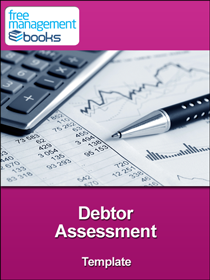
Debtor Assessment Template
This Debtor Assessment template will help you to assess your debtors and to see which ones pose the biggest financial risk. It also enables to quickly identify any products or services for which you may wish to adjust your terms of sale.
Getting paid for the services or products you provide as a business is vital to both short-term cash flow and long-term growth. Many businesses have been critically harmed by simply not staying current on the accounts receivables and failing to collect enough of the money that was owed to them. Extending lines of credit is a good way to build a loyal customer base, but it can also be taken advantage of when placed in the wrong hands. It is crucial that you as a manager understand just how important collecting all payments really is to the operation of the business as a whole.
To start reviewing your customer list and making sure that credit is not being given out in too risky a fashion, create a report that shows the average time it takes each customer to pay. Right off the bat, you should have a majority of your customers that you can consider ‘reliable’ and cross them off of your review list. Any customers that have a long average time to pay should be included on the list that you are going to review when deciding if a change in terms is necessary.
With your list to review in hand, start going over each customer on a case by case basis. You will need to be looking at your accounting software during this review to see what the patterns are in the payments that you receive. Are you getting payments on a reliable schedule each month, just a few weeks slower than other customers? That is actually not a big deal. Some industries, health care for example, are notorious slow to pay their bills because of the way the cash flows work. As long as they are reliably making a payment each month and there are no extended periods of time without a receipt, you can feel good about them continuing to pay their invoices and not leave you exposed.
The customers that you need to be concerned with are those that pay sporadically without any rhyme or reason. Those customers are likely having financial difficulty beyond simple cash flow problems, and could be at high risk of defaulting. Customers that fall into this category need to be dealt with immediately, because each day that goes by is another day further from when you should have received the money. Allowing delinquent customers to continue dragging on is one of the most common ways for a business to wind up in trouble.
When to decide on which customers to take action with, start by approaching them in a friendly and helpful manner. After all, they are your customers and you would like to keep it that way – so long as they can pay their bill. Offer them discount terms if they can pay quickly each month, or ask if twice-monthly billing would make it easier to handle the invoices when they arrive. As long as they are willing to work with you on a plan to keep their account current, there is no reason to get into threats at this time.
When the situation escalates and they don’t want to work with you, there are a couple of options. First, you should consider placing their orders on C.O.D. only and removing the credit option from their account. Obviously, this action takes out all risk, but might cause the customer to turn somewhere else. You could also lower their credit limit on a temporary basis until they can prove an ability to make consistent payments over time. Making these tough decisions as a manager is what will earn your salary and make you successful at what you do. Try to walk the fine line between customer service and collecting your money – if you can do it right, the customers will stick with you and the money will start rolling in once again.
As a manager, you will usually be expected to understand basic accounting concepts and communicate effectively with financial people in your own organization. You may also be asked to contribute financial data about your own business unit. The basic principles of accounting are best understood by considering some simple businesses and how they might document their financial activities.
Accrual accounting is considered to be the standard accounting practice for most organizations, and is mandated for organizations of any real size. It provides a more accurate financial picture, but is more difficult to administer. Terms like ‘revenue,’ ‘expenses,’ ‘gross profit,’ ‘depreciation,’ ‘bad debt,’ and ‘fixed assets’ have precise definitions when used in business accounting. You will also need to understand exactly what is meant by accounting terms like these.
